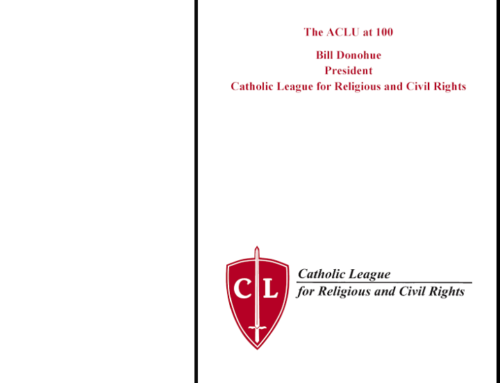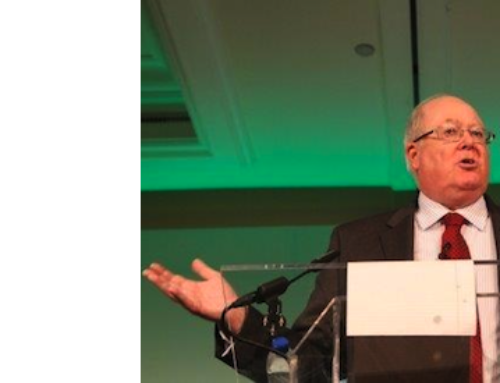Bill Donohue
President
Catholic League for Religious and Civil Rights
May 2013
On April 28, an editorial in the Newark Star-Ledger called on Newark Archbishop John J. Myers to resign. There should be a resignation, but it should not be limited to one person: the entire editorial board of the newspaper should resign immediately.
The occasion of the editorial is the alleged failure of the Newark Archdiocese to police Father Michael Fugee. In 2001, he was charged with groping a teenager while wrestling. After initially being found guilty, the verdict was overthrown by an appellate panel of judges. Fugee agreed to certain conditions, which the newspaper says have been violated. The Star-Ledger wants Archbishop Myers to resign because he allegedly did not hold Fugee to the terms of the agreement. As will soon be disclosed, this accusation is patently false.
Accompanying the editorial was a front-page story on Father Fugee. The Sunday article, which ran over 2,000 words, recounted various aspects of this issue. It did not mention, however, that in addition to being cleared by the civil courts, the archdiocesan review board cleared Fugee of any wrongdoing. Nor did it mention that the case was sent to Rome for review; no charges were brought against him. In other words, Fugee’s case was thrice thrown out. Also, the newspaper failed to mention that there has not been one allegation made against this priest in the past 12 years. So why is the Star-Ledger going ballistic?
The following two paragraphs from the editorial explain the basis of its complaint:
“Part of the [court] deal was an agreement that Fugee signed, along with the archdiocese, committing all parties to keeping Fugee away from minors. Fugee was not to work in any position involving children, or have any affiliation with youth groups. He could not attend youth retreats, or even hear the confession of minors.
“With the full knowledge and approval of Myers, Fugee did all of those things. Look at the picture of him clowning around with children [whose faces were obscured] in today’s paper, and it makes you want to scream a warning. The agreement was designed to prevent exactly that.”
Sounds ominous. But it is a lie. The editorial board intentionally distorted the agreement so it could make its case to hound Archbishop Myers out of office. It also smeared Fugee by suggesting that children are not safe in his company. Here is exactly what the agreement said:
“It is agreed and understood that the Archdiocese shall not assign or otherwise place Michael Fugee in any position within the Archdiocese that allows him to have any unsupervised contact with or to supervise or minister to any minor/child under the age of 18 or work in any position in which children are involved.” (My italics.) [Note: In the next paragraph, the identical language is used to hold Father Fugee to these terms.]
In other words, the court agreement expressly allowed Father Fugee to have contact with minors, provided he was supervised. Nothing in either the news story or the editorial even suggests that Fugee was at any time unsupervised in his contacts with minors. If the Star-Ledger had such evidence, it would have said so.
The news story is equally deceitful. At one point it comes clean by saying that the agreement “explicitly” mentions that “Fugee may not have unsupervised contact with children,” but then it immediately maintains that this is a rebuttable proposition. Referring to Archbishop Myers’ spokesman, Jim Goodness, it says that “Goodness denied the agreement had been breached, saying the archdiocese has interpreted the document to mean Fugee could work with minors as long as he is under the supervision of priests or lay ministers who have knowledge of his past and of the conditions of the agreement.” (My emphasis.)
Now, all of a sudden, the plain words of the agreement are seen as open to interpretation. But if the agreement says Fugee was not supposed to have unsupervised contact, what other plausible interpretation is there? The newspaper would have the reader believe that the agreement is ambiguous about this condition, when, of course, it is not.
The Star-Ledger makes the point that Father Fugee occasionally traveled outside his diocese. So what? Does it have evidence that he was without supervision? It cites his work in a Monmouth County church, St. Mary’s in Colts Neck, as a case in point. He was invited there by longtime friends and, more important, the church’s pastor, Father Thomas Triggs, knew of Fugee’s agreement with the prosecutor and made sure that he was supervised. In short, the agreement was not violated.
What is really going on here is an attempt to sunder Archbishop Myers—Fugee is not the man they want. They want Myers, and that is because they detest what he stands for.
The first editorial on Archbishop Myers was published by the Star-Ledger on April 17, 2002; it took him to task for his views on how best to handle allegations of sexual abuse. It said he “apparently still believes the church ought to decide first who is suspect before notifying civil authorities.” Let’s hope he always does.
Several years ago I was confronted by a female reporter in my office who challenged me on this very issue. She wanted to know why allegations against a priest were not made instantly available on the diocesan website. When I asked her for her boss’ phone number, she balked, wanting to know why. I told her that I was prepared to accuse her of sexually harassing me in my office and would demand that her name be posted on the media outlet’s website. She got the point.
Does the Star-Ledger get the point? Apparently not: it wants every bishop to call 911 whenever an accusation is made, no matter how baseless it is. This is its idea of justice—for priests.
In 2003, Archbishop Myers released a set of strict procedures and guidelines that affected every employee in the archdiocese. The “Archdiocese of Newark Policies on Professional and Ministerial Conduct” was a comprehensive code of conduct that should have been welcomed by everyone, including critics of the Catholic Church. Instead, the newspaper made fun of it.
The October 8, 2003 editorial in the Star-Ledger provided a good window into the paper’s thinking. John McLaughlin mocked the idea of finding “immoral behavior” offensive, commenting this must mean “no abortions or participation in abortions, euthanasia and homicide.” (Why he objects to punishing murderers he did not say.) He also wanted to know why non-Catholics, who voluntarily agreed to work in the archdiocese, had to abide by these standards. So much for institutional autonomy.
In fact, Myers’ autonomy is a problem for the newspaper. To wit: on May 7, 2004, it took him to task for saying that pro-abortion politicians should refrain from receiving Communion. Does the Star-Ledger think it has the right to police Myers, or that he should check in with them before making house rules? If Myers told the newspaper that it should vet all internal policies by him before making them final, they would go off the deep end.
In the last election, the Star-Ledger endorsed President Obama, supported gay marriage, ridiculed the “war on religion,” and took umbrage at Myers for encouraging Catholics to defend “marriage and life.” These sentiments are held dear by the editorial page editor, Tom Moran, an angry ex-Catholic. Three years ago he said he cut his “emotional ties to the church long ago.” If only he would.
Not surprisingly, the groups cited by the Star-Ledger who are upset with Archbishop Myers are all dissidents. Consider Theresa Padovano, who heads Voice of the Faithful in New Jersey. Voice is described as a “lay reform group.” In fact, it is a small collection of elderly Catholics and ex-Catholics who are at war with the Church over many issues.
Voice supports discriminatory legislation that exclusively targets the Catholic Church: it wants laws that suspend the statute of limitations on sexual abuse cases involving minors, but never pushes for public institutions to be held accountable to the same standard. In Connecticut, it actually sided with those lawmakers who wanted to take over the administrative structure of the parishes. Indeed, it crafted a strategic plan to do just this, thus showing what it thinks about separation of church and state. It lost in its bid to strip the Catholic Church of its First Amendment rights, but it was not for lack of trying. By the way, Theresa Padavano is an ex-nun activist married to Anthony Padavano, an ex-priest activist who is also at odds with Catholicism.
The next group cited is the New Jersey chapter of Survivors Network of those Abused by Priests (SNAP). It is labeled “a national advocacy and support group.” What it advocates is a war on the Catholic Church and what it supports is unlicensed counseling of alleged abuse victims. To be specific, the national leader, David Clohessy, has testified under oath that he has intentionally lied to the media about his work, and has offered numerous counseling sessions in Starbucks, without a license. At a conference attended by Catholic League allies, he bragged how important it is to manipulate the media with pictures of children. He also refused to contact the authorities after he learned that his own brother was a sexual predator, thus violating the very standard he says bishops fail to respect.
Last year, Voice joined with SNAP to protest the “House of Worship Protection Act” in Kansas. Represented by the ACLU, they challenged a law that would prohibit the intentional disruption of services in a house of worship, something the Brown Shirts were known to do. They lost, but their effort to destroy freedom of religion remains one of their low points.
The third group, bishopaccountability.org, is branded by the newspaper as a “watchdog group.” Attack dog would be more accurate. It posts the names of accused priests on its website, admitting that it “does not confirm the veracity of any actual allegation.” The head of this group, Terence McKiernan, boasted to a SNAP audience, “I hope we can find ways of sticking it to this man.” The man he wants to “stick it to” is Cardinal Timothy Dolan, the Archbishop of New York and the president of the United States Conference of Catholic Bishops. Without any evidence, McKiernan told the crowd of Catholic bashers that Dolan was “keeping the lid on 55 names.” To this day, McKiernan has never disclosed the names of these priests. He knows it’s a lie.
If the Star-Ledger were honestly concerned about the sexual abuse of minors, it wouldn’t play favorites with the public schools. But it does. In 2000, a public school teacher in Teaneck, New Jersey, James Darden, was charged with sexually abusing a minor. The teenage girl contacted the Bergen County Prosecutor’s Office and eventually Darden pled guilty.
The victim then filed a one-count complaint against Darden, and the Board of Education, and others, arguing they were liable under the New Jersey Child Sexual Abuse Act (CSAA). She lost in 2011. That is because the law was conveniently written to apply only to schools which stand in loco parentis to the student, and the appellate court held that the public school in that case could not be sued under CSAA because the in loco parentis test was not made.
And what did the Star-Ledger say about this? Nothing. Not only was there no editorial, there was no news story. If this had been a Catholic school that was able to skirt justice, the newspaper would have unloaded with both barrels.
At bottom, the Star-Ledger has unfairly maligned Archbishop Myers, and has treated Father Fugee like a political football. If Myers strapped a GPS tracking device on Fugee’s body, it wouldn’t satisfy the newspaper’s craving for punitive action. For these reasons, the editorial board should resign with dispatch. The members are a disgrace to the profession of journalism.








